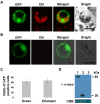A highly efficient rice green tissue protoplast system for transient gene expression and studying light/chloroplast-related processes
- PMID: 21961694
- PMCID: PMC3203094
- DOI: 10.1186/1746-4811-7-30
A highly efficient rice green tissue protoplast system for transient gene expression and studying light/chloroplast-related processes
Abstract
Background: Plant protoplasts, a proven physiological and versatile cell system, are widely used in high-throughput analysis and functional characterization of genes. Green protoplasts have been successfully used in investigations of plant signal transduction pathways related to hormones, metabolites and environmental challenges. In rice, protoplasts are commonly prepared from suspension cultured cells or etiolated seedlings, but only a few studies have explored the use of protoplasts from rice green tissue.
Results: Here, we report a simplified method for isolating protoplasts from normally cultivated young rice green tissue without the need for unnecessary chemicals and a vacuum device. Transfections of the generated protoplasts with plasmids of a wide range of sizes (4.5-13 kb) and co-transfections with multiple plasmids achieved impressively high efficiencies and allowed evaluations by 1) protein immunoblotting analysis, 2) subcellular localization assays, and 3) protein-protein interaction analysis by bimolecular fluorescence complementation (BiFC) and firefly luciferase complementation (FLC). Importantly, the rice green tissue protoplasts were photosynthetically active and sensitive to the retrograde plastid signaling inducer norflurazon (NF). Transient expression of the GFP-tagged light-related transcription factor OsGLK1 markedly upregulated transcript levels of the endogeneous photosynthetic genes OsLhcb1, OsLhcp, GADPH and RbcS, which were reduced to some extent by NF treatment in the rice green tissue protoplasts.
Conclusions: We show here a simplified and highly efficient transient gene expression system using photosynthetically active rice green tissue protoplasts and its broad applications in protein immunoblot, localization and protein-protein interaction assays. These rice green tissue protoplasts will be particularly useful in studies of light/chloroplast-related processes.
Figures








Similar articles
-
A highly efficient transient protoplast system for analyzing defence gene expression and protein-protein interactions in rice.Mol Plant Pathol. 2006 Sep;7(5):417-27. doi: 10.1111/j.1364-3703.2006.00346.x. Mol Plant Pathol. 2006. PMID: 20507457
-
A novel system for gene silencing using siRNAs in rice leaf and stem-derived protoplasts.Plant Methods. 2006 Jun 29;2:13. doi: 10.1186/1746-4811-2-13. Plant Methods. 2006. PMID: 16808845 Free PMC article.
-
Efficient isolation of protoplasts from rice calli with pause points and its application in transient gene expression and genome editing assays.Plant Methods. 2020 Nov 12;16(1):151. doi: 10.1186/s13007-020-00692-4. Plant Methods. 2020. PMID: 33292393 Free PMC article.
-
Isolation, culture, and transient transformation of plant protoplasts.Curr Protoc Cell Biol. 2014 Jun 3;63:2.8.1-17. doi: 10.1002/0471143030.cb0208s63. Curr Protoc Cell Biol. 2014. PMID: 24894837 Review.
-
Isolation, Purification, and Application of Protoplasts and Transient Expression Systems in Plants.Int J Mol Sci. 2023 Nov 29;24(23):16892. doi: 10.3390/ijms242316892. Int J Mol Sci. 2023. PMID: 38069215 Free PMC article. Review.
Cited by
-
A simple and efficient transient transformation for hybrid aspen (Populus tremula × P. tremuloides).Plant Methods. 2012 Aug 7;8(1):30. doi: 10.1186/1746-4811-8-30. Plant Methods. 2012. PMID: 22871142 Free PMC article.
-
The PPR-SMR Protein ATP4 Is Required for Editing the Chloroplast rps8 mRNA in Rice and Maize.Plant Physiol. 2020 Dec;184(4):2011-2021. doi: 10.1104/pp.20.00849. Epub 2020 Sep 14. Plant Physiol. 2020. PMID: 32928899 Free PMC article.
-
Multiplex CRISPR/Cas9-mediated genome editing of the FAD2 gene in rice: a model genome editing system for oil palm.J Genet Eng Biotechnol. 2021 Jun 11;19(1):86. doi: 10.1186/s43141-021-00185-4. J Genet Eng Biotechnol. 2021. PMID: 34115267 Free PMC article.
-
E3 ligase, the Oryza sativa salt-induced RING finger protein 4 (OsSIRP4), negatively regulates salt stress responses via degradation of the OsPEX11-1 protein.Plant Mol Biol. 2021 Feb;105(3):231-245. doi: 10.1007/s11103-020-01084-x. Epub 2020 Oct 20. Plant Mol Biol. 2021. PMID: 33079323
-
OsFTL4, an FT-like Gene, Regulates Flowering Time and Drought Tolerance in Rice (Oryza sativa L.).Rice (N Y). 2022 Sep 6;15(1):47. doi: 10.1186/s12284-022-00593-1. Rice (N Y). 2022. PMID: 36068333 Free PMC article.
References
-
- De Sutter V, Vanderhaeghen R, Tilleman S, Lammertyn F, Vanhoutte I, Karimi M, Inzé D, Goossens A, Hilson P. Exploration of jasmonate signalling via automated and standardized transient expression assays in tobacco cells. Plant J. 2005;44(6):1065–1076. doi: 10.1111/j.1365-313X.2005.02586.x. - DOI - PubMed
-
- Fischer R, Hain R. Tobacco protoplast transformation and use for functional analysis of newly isolated genes and gene constructs. Methods Cell Biol. 1995;50:401–410. - PubMed
LinkOut - more resources
Full Text Sources
Other Literature Sources

